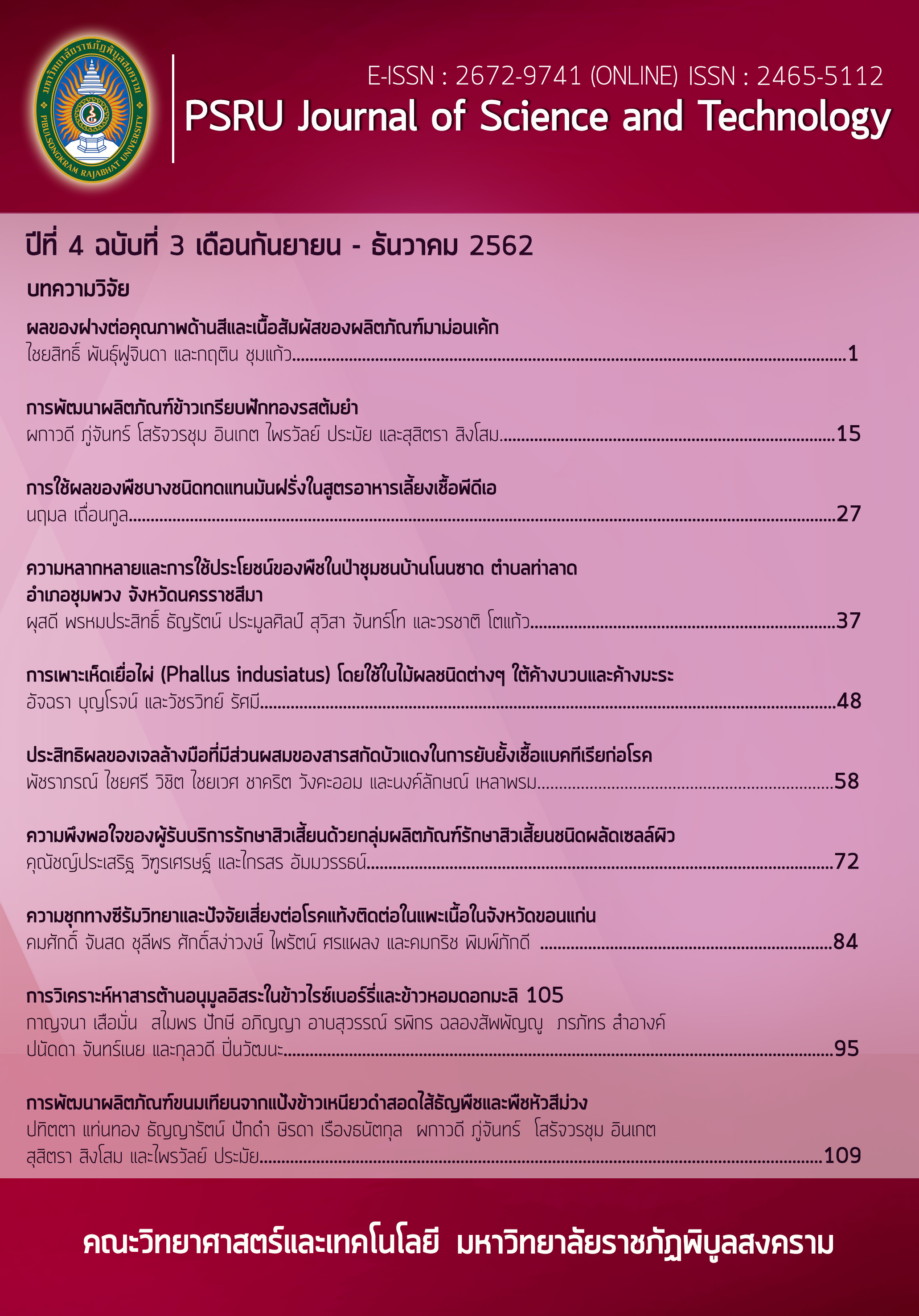THE DEVELOPMENT OF KANOM-TIAN FROM BLACK GLUTINOUS RICE FLOUR STUFFED WITH CEREAL AND PURPLE TUBERS
Keywords:
Kanom-Tian, Black glutinous rice flour, AntioxidantAbstract
The objective of this research was to develop Kanom-Tian product with high nutritive value and antioxidants. Glutinous rice flour was replaced by black glutinous rice flour (BGRF) at the level of 5, 15, 25, 35 and 45 percentage (%) by weight of flour. The filling ingredient of Kanom-Tian was developed using cereal and tubers, including purple sweet potato, taro, and black beans. The physical and chemical properties were studied as well as sensory evaluation. The result showed that the L* and b* values of Kanom-Tian flour were decreased, while the a* value was increased with the increase in the amount of BGRF (p≤0.05). Sensory evaluation was conducted by the 9-Point Hedonic Scale Test for the appearance, color, odor, taste, texture and overall liking. Kanom-Tian with 15% BGRF had the highest liking score for texture and overall liking (p≤0.05). For the development of filling ingredients from purple sweet potato, taro, and black bean, it was found that purple sweet potato filling consisted of the most anthocyanin and total phenolic contents. Corresponding to the result of the sensory evaluation that purple sweet potato and taro filling exhibited the highest liking score. Chemical composition analysis of Kanom-Tian with 15% BGRF stuffed with purple sweet potato was studied and the result showed that it contained 4.32% protein, 6.58% fat, 0.87% ash, 3.73% fiber, 77.77% carbohydrate and 387.59 Kcal of energy per 100 g sample. In addition, total anthocyanin content, total phenolic content, and DPPH radical scavenging ability of 100 grams (DW) of Kanom-Tian with 15% BGRF stuffed with purple sweet potato were 11.06 mg, 70.97 mg GAE, and 48.98 mg TEAC, respectively.
References
ไชยสิทธิ์ พันธุ์ฟูจินดา เลอลักษณ์ เสถียรรัตน์ อรวัลภ์ อุปถัมภานนท์. (2560). การพัฒนาผลิตภัณฑ์บราวนี่โดยใช้แป้งข้าวเหนียวดำทดแทนแป้งสาลี. วารสาร มทร.อีสาน ฉบับวิทยาศาสตร์และเทคโนโลยี, 10(1), 106-119.
ดำเนิน กาละดี. (2554). ข้าวก่ำ (ข้าวเหนียวดำ) ทรัพยากรข้าวไทยที่ถูกลืม. เชียงใหม่: หน่วยวิจัยข้าวก่ำ สถาบันวิจัยวิทยาศาสตร์และเทคโนโลยี มหาวิทยาลัยเชียงใหม่.
นรินทร์ เจริญพันธ์. (2562). การผลิตไอศกรีมไขมันต่ำจากน้ำนมข้าวเหนียวดำ. วารสารเทคโนโลยีการอาหาร มหาวิทยาลัยสยาม, 14(1), 1-11.
นิพัฒน์ ลิ้มสงวน ประมวล ทรายทอง และสุภัคชนม์ คล่องดี. (2561). ความสามารถของถั่วชนิดต่างๆ ในการต้านอนุมูลอิสระและส่งเสริมการเจริญเติบโตของแบคทีเรียแลคโตบาซิลลัส. วารสารวิทยาศาสตร์และเทคโนโลยี, 26(5), 777-789.
พรพาชื่น ชูเชิด ศิริพร เรียบร้อย คิม และอัญชนีย์ อุทัยพัฒนาชีพ. (2560). การเปรียบเทียบปริมาณสารสำคัญในข้าวเหนียวดำ 6 สายพันธุ์. Science and Technology RMUTT Journal, 7(2), 271-279.
พาขวัญ มีชาญเชาว์. (2559). ผลิตภัณฑ์ขนมเทียนแป้งข้าวกล้องไรซ์เบอร์รี่แช่แข็ง. วิทยานิพนธ์คหกรรมศาสตรมหาบัณฑิต สาขาคหกรรมศาสตร์ คณะเทคโนโลยีคหกรรมศาสตร์ มหาวิทยาลัยเทคโนโลยีราชมงคลพระนคร.
พุดน้ำบุตย์. (2552). รวมสูตรขนมไทย. สำนักพิมพ์ไทยควอลิตี้บุ๊คส์, กรุงเทพฯ.
วชิรพงศ์ เยาว์ฤทธิกร ปาริสุทธิ์ เฉลิมชัยวัฒน์ และอบเชย วงศ์ทอง. (2561). ผลของชนิดและปริมาณของแป้งข้าวเหนียวลืมผัวต่อคุณภาพของขนมเทียน. ใน การประชุมวิชาการของมหาวิทยาลัยเกษตรศาสตร์ ครั้งที่ 56 (น. 863-872). กรุงเทพฯ: มหาวิทยาลัยเกษตรศาสตร์.
วิลาวัลย์ บุณย์ศุภา กรรณิการ์ ทองดอนเปรียง และพันธิวา แก้วมาตย์. (2561). คุณสมบัติทางเคมี กิจกรรม การต้านอนุมูลอิสระและการทดสอบทางประสาทสัมผัสของน้ำส้มสายชูหมักจากข้าวเหนียวดำ 2 แบบ. วารสารวิชาการ วิทยาศาสตร์และเทคโนโลยี มหาวิทยาลัยราชภัฎนครสวรรค์, 9(10), 69-78.
AOAC, (2016). Official Methods of Analysis. (20th ed). Washington, D.C.
Giusti, M. M., & Wrolstad, R. E. (2005). Characterization and measurement of anthocyanins by UV-Visible spectroscopy. Wrolstad, R.E., Acree, T.E., Decker, E.A., Penner, M.H., Reid, D.S., Schwartz, S.J., Shoemaker, C.F., Smith, D. and Sporns, P., editor. Handbook of Food Analytical Chemistry. U.S.A.: Wiley-Interscience, New Jersey.
Guajardo-Flores, D., García-Patiño, M., Serna-Guerrero, D., Gutiérrez-Uribe, J. A., & Serna-Saldívar, S. O. (2012). Characterization and quantification of saponins and flavonoids in sprouts, seed coats and cotyledons of germinated black beans. Food chemistry, 134(3), 1312-1319.
Gunathilake, K. G. T., Herath, T., & Wansapala, J. (2016). Comparison of physicochemical properties of selected locally available legumes varieties (Mung bean, Cowpea and Soybean). Potravinarstvo, 10(1), 424-430.
Ji, H., Zhang, H., Li, H., & Li, Y. (2015). Analysis on the nutrition composition and antioxidant activity of different types of sweet potato cultivars. Food and Nutrition Sciences, 6(1), 161-167.
Lee, J. H., Jeon, J. K., Kim, S. G., Kim, S. H., Chun, T., & Imm, J. Y. (2011). Comparative analyses of total phenols, flavonoids, saponins and antioxidant activity in yellow soy beans and mung beans. International Journal of Food Science & Technology, 46(12), 2513-2519.
Pellati, F., Benvenuti, S., Magro, L., Melegari, M., & Soragni, F. (2004). Analysis of phenolic compounds and radical scavenging activity of Echinacea spp. Journal of Pharmaceutical and Biomedical Analysis. 35(2), 289-301.
Simsek, S., & El, S. N. (2015). In vitro starch digestibility, estimated glycemic index and antioxidant potential of taro (Colocasia esculenta L. Schott) corm. Food chemistry, 168, 257-261.
Singleton, V. L., Orthofer, R., & Lamuela-Raventós, R. M. (1999). Analysis of total phenols and other oxidation substrates and antioxidants by means of folin-ciocalteu reagent. Methods in enzymology, 299, 152-178.
Sompong, R., Siebenhandl-Ehn, S., Linsberger-Martin, G., & Berghofer, E. (2011). Physicochemical and antioxidative properties of red and black rice varieties from Thailand, China and Sri Lanka. Food chemistry, 124(1), 132-140.
Tang, Y., Cai, W., & Xu, B. (2015). Profiles of phenolics, carotenoids and antioxidative capacities of thermal processed white, yellow, orange and purple sweet potatoes grown in Guilin, China. Food Science and Human Wellness, 4(3), 123-132.
Downloads
Published
How to Cite
Issue
Section
License
กองบรรณาธิการขอสงวนสิทธิ์ในการปรับปรุงแก้ไขตัวอักษรและคำสะกดต่างๆ ที่ไม่ถูกต้อง และต้นฉบับที่ได้รับการตีพิมพ์ในวารสาร PSRU Journal of Science and Technology ถือเป็นกรรมสิทธิ์ของคณะวิทยาศาสตร์และเทคโนโลยี มหาวิทยาลัยราชภัฏพิบูลสงคราม และ
ผลการพิจารณาคัดเลือกบทความตีพิมพ์ในวารสารให้ถือมติของกองบรรณาธิการเป็นที่สิ้นสุด







